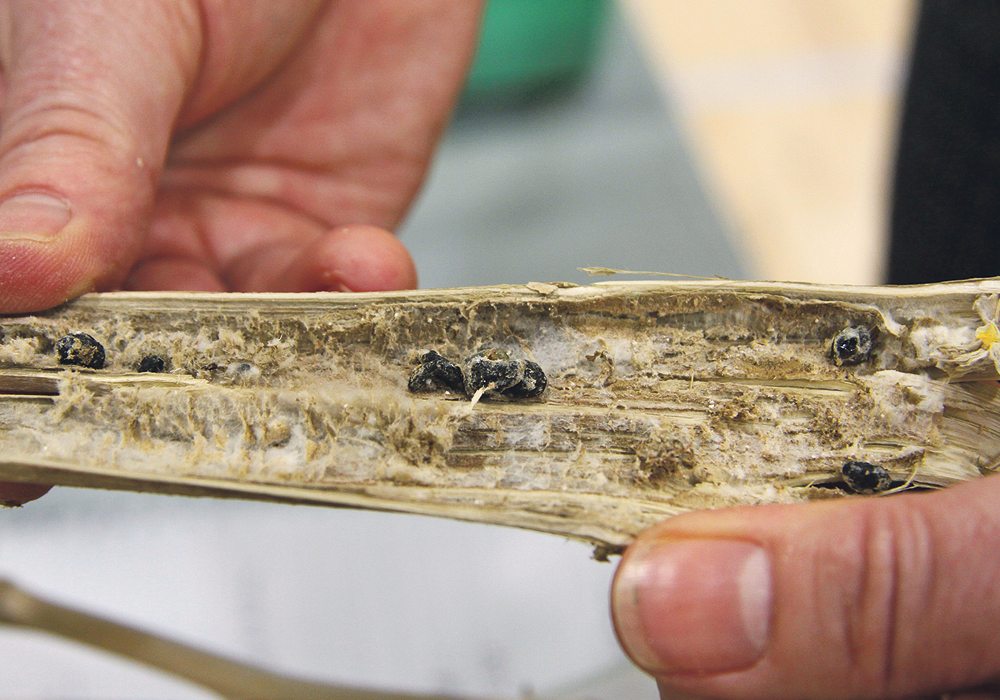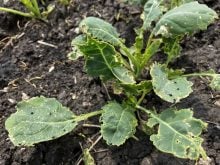Growing a tolerant canola variety is one way producers can reduce the risk of the fungal disease cutting their yields
The word sclerotinia doesn’t sound nearly as scary as blackleg, and unlike clubroot, the sclerotinia fungus doesn’t remain in cropland for 20 years.
However, while it isn’t as nasty as those diseases, sclerotinia, also known as white mould, should not be ignored.
“The reality is it’s the most ubiquitous and probably the biggest yield grabber when you look (at canola diseases) across Western Canada,” said Angela Brackenreed, a Canola Council of Canada agronomist in Manitoba.
“I think it needs to be more top of producers’ mind.”
Read Also

Growing garlic by the thousands in Manitoba
Grower holds a planting party day every fall as a crowd gathers to help put 28,000 plants, and sometimes more, into theground
Brackenreed helped organize the canola council’s agronomy workshop, CanoLab, held mid-March in Brandon. This year’s event also featured information on soybean agronomy, and that component was branded as SoyLab.
Keith Gabert, a council agronomist in Alberta, and Lone Buchwaldt, an Agriculture Canada plant pathologist, hosted a session in Brandon about managing sclerotinia.
Gabert agreed that sclerotinia deserves more attention.
“If we could get a handle on it and manage it, it would be a real benefit to the growers.”
Sclerotinia infects canola at the time of bloom and thrives under a dense canopy of canola plants, where the micro-climate is warm and humid. The disease causes lesions to form on plant stems, cutting off the flow of nutrients and water in the plant.
Research shows that an infected plant reduces canola seed yield by about 50 percent, which means a field with 10 percent infection will lose five percent.
Many growers may not worry about that yield loss because sclerotinia usually develops when conditions are close to ideal for maximum canola yields.
In other words, producers are willing to accept a five, 10 or 15 percent yield loss if they’re still getting 47 bushels per acre.
“It’s penalizing a good crop, which is much more acceptable to a grower than penalizing a poor crop,” Gabert said.
“That’s why they tend to tolerate it a little more.”
However, those lost bushels add up when conditions are ripe for sclerotinia across an entire region.
In 2016, about 15 to 20 percent of canola plants in Manitoba had sclerotinia, and the severity of infection was higher than normal. Assuming it was 20 percent, Manitoba canola yields likely dropped by 10 percent, cutting overall production by 300,000 tonnes.
Fungicides are one tool for controlling sclerotinia stem rot and preserving yield.
Another is a canola variety that is tolerant of white mould.
There are a few canola varieties on the market with sclerotinia tolerance, but Buchwaldt is hoping that number increases over the next few years.
Buchwaldt, who works in Saskatoon, has been studying sclerotinia tolerant traits in canola since 2013.
She found brassica napus plants in South Korea, Japan and Pakistan that were naturally resistant to sclerotinia.
Subsequent testing showed that the genes in the plants from Pakistan were the most tolerant. They stood up to 17 different groups of sclerotinia fungi isolates collected from canola fields across Western Canada.
The results were particularly encouraging because the genetic tolerance is based on a number of genes, making it more difficult for the sclerotinia fungus to mutate and defeat the resistance, Buchwaldt said.
“It’s very, very unlikely that these isolates will overcome all of these five genes.”
Buchwaldt handed the genetics over to canola breeders at life science companies, who are now breeding the traits into canola varieties.
One challenge for the breeders will be the nature of brassica napus because it has a higher level of erucic acid than canola.
“The plant breeders will have to breed that out while retaining the resistance to sclerotinia,” Buchwaldt said.
If development proceeds on schedule, it’s possible that new varieties of canola with sclerotinia tolerance could be on the market in a few years.
At this point it’s hard to know if growers will pay extra for such a trait, but the benefits are fairly obvious.
“Sclerotinia tolerant varieties will definitively give you a higher yield potential because you have less disease impact,” Gabert said.
The trait probably doesn’t make sense in humid parts of the Prairies, such as the Red River Valley, where growers routinely spray canola with a fungicide to ward off sclerotinia.
Brackenreed said sclerotinia tolerant varieties are likely more useful in a region where growers are “on the cusp of whether or not they would spray.”
“Then you have some of that background protection if you don’t (spray),” she said.
“Sclerotinia tolerance is a great tool if you’re unsure about whether you’re going to use that fungicide application.”
Canola isn’t the only crop in Western Canada that’s susceptible to sclerotinia, Buchwaldt said.
Growing both soybeans and canola, for example, can increase the amount of disease inoculum in the soil and the impact of sclerotinia.
“If you have soybeans, sunflowers and lentils and bean in your rotation, then you want a sclerotinia resistant canola.”


















